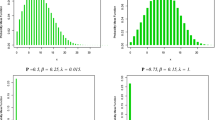Summary
A comparison has been made between the estimates obtained from maximum likelihood estimation of gamma, inverse normal, and normal distribution models for stage-frequency data. Results have been compared for six of sets of test data, and from many sets of simulated data. It is concluded that (1) some estimates may differ substantially between the models, (2) estimates from the correct model have little bias, and estimated standard errors are generally close to theoretical values, (3) there are problems in determining degrees of freedom for chi-squared goodness of fit tests, so that it is best to compare test statistics with simulated distributions, and (4) goodness of fit tests may not discriminate well between the three models.
Similar content being viewed by others
References
Bellows, T. S. andM. H. Birley (1981) Estimating developmental and mortality rates and stage recruitment from insect stage-frequency data.Res. Popul. Ecol. 23: 232–244.
Kemp, W. P., B. Dennis andP. L. Munholland (1989) Modelling grasshopper phenology with diffusion processes. 118–127. InL. L. McDonald, B. F. J., Manly, J. A. Lockwood andJ. A. Logan (eds)Estimation and Analysis of Insect Populations. Spring-Verlag Lecture Notes in Statistics, Berlin.
Kempton, R. A. (1979) Statistical analysis of frequency data obtained from sampling an insect population grouped by stages. 401–418. InJ. K. Ord, G. P. Patil andC. Taille (eds)Statistical Distributions in Scientific Work. International Cooperative Publishing House, Maryland.
Kobayashi, S. (1968) Estimation of the individual number entering each development stage in an insect population.Res. Popul. Ecol. 10: 40–44.
Manly, B. F. J. (1974) A comparison of methods for the analysis of stage-frequency data.Oecologia 17: 335–348.
Manly, B. F. J. (1985)The Statistics of Natural Selection on Animal Populations. Chapman and Hall, London.
Manly, B. F. J. (1989a) A review of methods for the analysis of stage-frequency data. 3–69. InL. L. McDonald, B. F. J. Manly, J. A. Lockwood andJ. A. Logan (eds)Estimation and Analysis of Insect Populations. Springer-Verlag Lecture Notes in Statistics, Berlin.
Manly, B. F. J. (1989b)Stage-Structured Populations: Sampling Analysis and Simulation. Chapman and Hall, London (in press).
Munholland, P. L., J. D. Kalbfleisch andB. Dennis (1989) A stochastic model for insect life history data. 136–144. InL. L. McDonald, B. F. J. Manly, J. A. Lockwood andJ. A. Logan (eds)Estimation and Analysis of Insect Populations. Springer-Verlag Lecture Notes in Statistics, Berlin.
Reed, T. E. andW. J. Schull (1968) A general maximum likelihood program.Amer. J. Hum. Genet. 20: 579–580.
Straalen, N. M. van (1982) Demographic analysis of arthropod populations using a continuous stage variable.J. Anim. Ecol. 51: 769–783.
Qasrawi, H. (1966)A Study of the Energy Flow in a Natural Population of the Grasshopper Chorthippus ParallelusZett. (Orthoptera Acridae). Ph. D. Thesis, University of Exeter.
Author information
Authors and Affiliations
Rights and permissions
About this article
Cite this article
Manly, B.F.J., Seyb, A. A comparison of three maximum likelihood models for stage-frequency data. Res Popul Ecol 31, 367–380 (1989). https://doi.org/10.1007/BF02513212
Issue Date:
DOI: https://doi.org/10.1007/BF02513212




